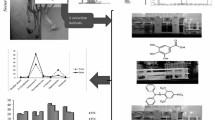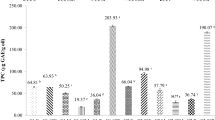Abstract
The essential oil composition and in vitro antioxidant activity of eight important betel vine landraces, such as Balia, Chandrakala, Dandabalunga, Desibangla, Godibangla, Karpada local, Maghai and Nahua were evaluated in this research. GC and GC-MS analysis of the essential oil resulted in identification of 50 compounds representing 95.97% of the oil. Major compounds were eugenol, terpinolene, terpinene, cadinene, caryophyllene, 3-carene, etc. The plant essential oil was also subjected to screening for the evaluation of their antioxidant activities using 2,2-diphenyl-l-picrylhydrazyl assay. The highest antioxidant activity was shown by Balia landraces, whereas the lowest activity by Godibangla landraces. Essential oil showed a great variety of compounds in their chemical composition and antioxidant activity. This might be due to the affect of different environmental factors and soil nutrients of betel vine cultivating zones. The GC-MS chromatogram with antioxidant activity of the above betel vine landraces would not only help to select the elite chemotypes, but also to enhance their future industrial applications.
Similar content being viewed by others
Abbreviations
- DPPH:
-
2,2-diphenyl-l-picrylhydrazyl
References
Abrahim N.N., Kanthimathi M.S. & Abdul-Aziz A. 2012. Piper betle shows antioxidant activities, inhibits MCF-7 cell proliferation and increases activities of catalase and superoxide dismutase. BMC Comp. Alter. Med. 12: 220.
Chakraborty D. & Shah B. 2011. Antimicrobial, antioxidative and antihemolytic activity of Piper betel leaf extracts. Int. J. Pharm. Pharmac. Sci. 3 (Suppl. 3): 192–199.
Dasgupta N. & De B. 2004. Antioxidant activity of Piper betle L. leaf extract in vitro. Food Chem. 88: 219–224.
Guha P. 2006. Betel leaf: the neglected green gold of India. J. Hum. Ecol. 19: 87–93.
Gundala S.R., Yang C., Mukkavilli R., Paranjpe R., Brahmbhatt M., Pannu V., Cheng A., Reid M.D. & Aneja R. 2014. Hy-droxychavicol, a betel leaf component, inhibits prostrate cancer through ROS-driven DNA damage and apoptosis. Toxicol. Appl. Pharmacol. 280: 86–96.
Hassiotis C.N., Ntana F., Lazari D.M., Poulios S. & Vlachonasios K.E. 2014. Environmental and developmental factors affect essential oil production and quality of Lavandula angustifolia during flowering period. Ind. Crops Prod. 62: 359–366.
Jane N.S., Deshmukh A.P. & Joshi M.S. 2014. Review of study of different diseases on betelvine plant and control measure. Int. J. Appl. Innov. Engin. Manag. 3: 560–563.
Lei D., Chan C.P., Wang Y.J., Lin B.R., Huang C.H., Lee J.J., Chen H.M. & Jeng J.H. 2003. Antioxidative and antiplatelet effects of aqueous inflorescence Piper betle extract. J. Agric. Food Chem. 51: 2083–2088.
Martin P. & Chang X. 2013. Production potential and crop agronomy of sweet gale (Myrica gale L.) in the north of Scotland. Ind. Crops Prod. 46: 39–49.
Misra P., Kumar A., Khare P., Gupta S., Kumar N. & Dube A. 2009. Pro-apoptotic effect of the landrace Bangla Mahoba of Piper betle on Leshmania donovani may be due to the high content of eugenol. J. Med. Microbiol. 58: 1058–1066.
Thurairajah N. & Rahim Z.H.A. 2007. The crude aqueous extract of Piper betle L. and its antibacterial effect towards Streptococcus mutans. Amer. J. Biotechnol. Biochem. 3: 10–15.
Rahimmalek M., Mirzakhani M. & Pirbalouti A.C. 2013. Essential oil variation among 21 wild myrtle (Myrtus communis L.) populations from different geographical regions in Iran. Ind. Crops Prod. 51: 328–333.
Rathee J.S., Patro B.S., Mula S., Gamre S. & Chattopadhyay S. 2006. Antioxidant activity of Piper betel leaf extract and its constituents. J. Agric. Food Chem. 54: 9046–9054.
Rawat A.K.S., Tripathi R.D., Khan A.J. & Balsubrahmanyam V.R. 1989. Essential oil components as markers for identification of Piper betle L. cultivars. Biochem. Syst. Ecol. 17: 38–55.
Salleh M.N., Runnie I., Roach P.D., Suhailla-Mohamed & Abey-wardena M.Y. 2002. Inhibition of low-density lipoprotein oxidation and up-regulation of low density lipoprotein receptor in HepG2 cells by tropical plant extracts. J. Agric. Food Chem. 50: 3693–3697.
Sangwan N.S., Farooqi A.H.A., Shabih F. & Sangwan R.S. 2001. Regulation of essential oil production in plants. Plant Growth Reg. 34: 3–21.
Saxena M., Khare N.K., Saxena P., Syamsundar K.V. & Srivas-tava S.K. 2014. Antimicrobial activity and chemical composition of leaf oil in two varieties of Piper betle from northern plains of India. J. Sci. Ind. Res. 73: 95–99.
Sazwi N.N., Nalina T. & Rahim Z.H.A. 2013. Antioxidant and cy-toprotective activities of Piper betle, Areca catechu, Uncaria gambir and betel quid with and without calcium hydroxide. BMC Comp. Alt. Med. 13: 351.
Shah G.A., Islam T., Sharma E., Telang S. & Malla B.S. 2013. Assessment of preliminary phytochemical screening and antioxidant potential of different extracts of Piper betle L. leaves. Int. J. Pharm. Sci. Rev. Res. 20: 189–192.
Shivashankara K.S., Roy T.K. & Geetha G.A. 2012. Antioxidant capacity, radical scavenging ability, total phenols and flavonoids in three types of betelvine (Piper betle L.) J. Spices Arom. Crops 21: 64–67.
Singtongratana N., Vadhanasin S. & Singkhonrat J. 2013. Hy-droxychavicol and eugenol profiling of betel leaves from Piper betle L. obtained by liquid-liquid extraction and supercritical fluid extraction. Kasetsart J. (Nat. Sci.) 47: 614–623.
Sugumaran M., Suresh Gandhi M., Sankarnarayanan K., Yokesh M., Poornima M. & Rajasekhar S.R. 2011. Chemical composition and antimicrobial activity of vellaikodi variety of Piper betle Linn leaf oil against dental pathogens. Int. J. Pharm. Tech. Res. 4: 2135–2139.
Suppakul P., Ead N.S. & Phoopuritham P. 2006. Antimicrobial and antioxidant activities of betel oil. Kasetsart J. (Nat. Sci.) 40: 91–100.
Acknowledgements
The authors are grateful to Prof. Dr. S.C. Si, Dean, Centre of Biotechnology, and Prof. Dr. M.R. Nayak, President, Siksha ‘O’ Anusandhan University, Orisha, India, for providing facilities and encouraging throughout.
Author information
Authors and Affiliations
Corresponding author
Rights and permissions
About this article
Cite this article
Das, S., Parida, R., Sandeep, I.S. et al. Chemical composition and antioxidant activity of some important betel vine landraces. Biologia 71, 128–132 (2016). https://doi.org/10.1515/biolog-2016-0030
Received:
Accepted:
Published:
Issue Date:
DOI: https://doi.org/10.1515/biolog-2016-0030




